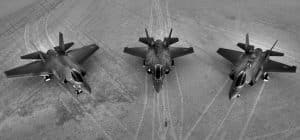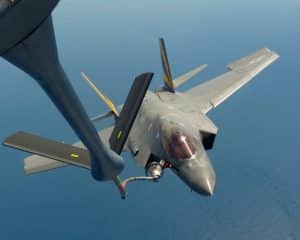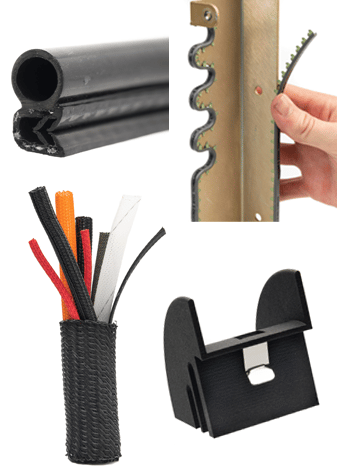The Pentagon’s F-35 Joint Program Office and Lockheed Martin just wrapped up a $34 billion agreement for the production and delivery of 478 F-35As at the lowest price in the program’s history. The F-35A unit cost of $77.9 million represents an estimated overall 12.8% reduction vs. the pricing on the previous 11-14 lots.

In 2015, the GAO was tasked with optimizing the F-35 program, and one of the key areas was affordability and lowering the flyaway price. The F-35 program office has additional planned “Blueprint for Affordability” initiatives which could save ~$8 billion in F-35 costs if they are fully realized.
DTi could help Lockheed to offset this drop in revenue with a program cost saving of ~$6.5 million by switching just one component. And that component is far easier and simpler to install and yields best-in-class performance.
What is this Miracle Component?
Simply replace all the glued-in nylon grommets aka MS21266 with Spring-Fast® Grommet Edging M22529/2.
And yes…the product is fully qualified as an FAA-approved replacement part, and already has NAVAIR approval.
We estimate savings of $6.5 million in just component and direct labor charges.
The legacy glued nylon grommet was patented in the 1940s, and while it may have been state-of-the-art for its time, new technology has eclipsed this slow, messy and costly process.
The savings are significant because M22529/2 has a far lower direct labor install cost than MS21266 because it:
– Snaps into place without adhesive
– Has superior retentive strength without adhesive
– Immediate wire/harness routing – no fixturing or cure time delays (delays are NOT factored into these savings)
Grommets may be small but have a big impact on the EWIS. They protect wiring from chafing, arcing, sparking, and fires, but surprisingly, chafing even at relatively low levels creates widespread problems.
NAVAIR data shows that the biggest single reason (at 37%) why aircraft were designated as AOG (Aircraft on Ground) or NORS (Non-Operational Ready Status) was wiring discrepancies due to chafe. Chafe is a significant drag on readiness, availability, and efficiency and clearly impacts medium to long-term operational costs.

The legacy MS21266 grommet relies on a costly, labor-intensive, and multi-step process.
- Multiple items for application and safety have to be gathered in the preparation phase.
- Edge preparation – abrasion and cleaning – is required for proper adhesion.
- The nylon MS21266 has no inherent retentive strength so has to be glued to the edge using Pliobond.
- MS21266 tends to straighten (vs. conforming), so tape has to be applied to hold it in place until the glue cures.
- Excess adhesive after curing has to be cleaned with a MEK solvent, cloths, and elbow grease.
- Dis-bonding happens frequently and leads to rework – adding to the cost of poor quality.
- Over time, the nylon grommet and adhesive are prone to failure from flight loads and stresses.
Why Spring-Fast M22529/2 Is A Better Product
- Fast and easy finger pressure application – it snaps into place without glue.
- Proven high performance with a polymer-coated ultra-thin CRES substrate.
- Caterpillar-style opposing finger-like castles exert a compression force for retention without glue.
- Passed 20/20/20 G static load tests – even when 4 castles are cut to provide clearance for an Adel-clamp support clip.
- Minimal FOD footprint of shop consumables vs. the glued nylon grommet (gloves, cheesecloth, IPA wipes, adhesive, tape, solvent, masks, etc.).
- NAVAIR Qualified.
How the Costs Were Calculated
For both grommets, we estimated the time in minutes for each step in the install operation and used that to calculate the cost per grommet using a $200 WRAP rate.
Installation Cost per grommet MS21266 $83.68
Installation Cost per grommet M22529/2 $29.00 (65% lower)
This cost was then applied to the number of planes (478) and penetrations (250).
Note: We can provide the spreadsheet if you would like to input your own data/assumptions.
Additional Savings – NOT included in the estimate
Scrap: The model compares precut 12.75” strips. However, M22529/2 can be supplied on reels and cut to length with minimal scrap for a very high yield / minimal scrap. In contrast, MS21266 is supplied only as precut strips so has to be cut to fit. For example, on a standard 3″ diameter penetration with a circumference of 9.4″, cutting the 12.75″ strip results in 3.35″ of scrap (26%).
Nylon vs. Teflon: The model assumes the use of low-cost nylon grommets. However, if Teflon grommets are used, the savings will increase as Teflon costs 10 to 28 times more per strip than nylon. Nylon strip costs ~$0.35. Teflon variants can range from $3.50/$9.95 per strip.
Consumables: MS21266 requires consumables of adhesive, IPA wipes, solvents, fixturing tape, gloves, masks & clean-up cloths. M22529/2 needs only IPA wipes. Fewer consumables yield less general overhead.
Efficiency/Productivity Improvements: Using M22529/2 frees up time to be allocated to other tasks.
– Per grommet, it saves 17.2 minutes.
– Per plane with 250 grommets, it saves 71.6 hours.
– Across this contract for 487 planes, it will save 34,901 man-hours.
A strong contributor to margin, efficiency, and backlog reduction.
Foreign Object Debris/Damage: M22529/2 reduces FOD as far fewer items have to be taken onto the plane. In addition pre-cutting the grommets will yield even greater efficiency and less FOD because techs will only need to carry the grommet and an IPA wipe onto the plane – no cutting tools at all.
Find out more about Spring-Fast grommet edging here

